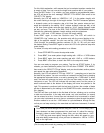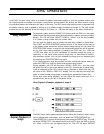
You can use the Dot Display function to examine any pattern, whether programmed
in real time or step write. This is a good way to learn what rhythms look like when
displayed visually–you’ll find that even complex rhythms quantized at 1/32 look
really simple on the Dot Display.
Beat Exchange
Once a pattern is programmed, you cannot re-program the quantize rate. However,
the Beat Exchange function enables you to switch the quantize rate of an existing
pattern between 1/12 and 1/24, or 1/16 and 1/32. This is done in the following
manner: after selecting your pattern, press BEAT. The LCD will show “BEAT
EXCHANGE ?“. Pressing the +1/YES key carries out the Beat Exchange
function-the LCD will switch to “BEAT EXCHANGING!", then revert to the
“SELECT PTN pp" display. Alternatively, pressing the -1/NO key will cancel the
Beat Exchange function.
If you’re not sure what quantize rate is set on your selected pattern, simply press
REAL TIME WRITE, and the LCD will show “REAL L=//,Q=1/qq”; “qq” is the
Quantize rate. If the Quantize rate is 12 (or 16) the Beat exchange will switch
it to 24 (or 32), and vice versa.
If, by mistake, you have selected a preset pattern, pressing the BEAT key will
call up the “PRESET PTN AREA!" display on the LCD, which will quickly revert
to the “SELECT PTN pp" display, allowing you to select another pattern.
The Beat Exchange function is useful when programming patterns in the step
write mode, as you can use a low quantize rate to enter the simpler rhythms, then
use the BEAT EXCHANGE function to switch to a higher quantize rate and enter
more complex rhythms. This is described in the STEP WRITE PATTERN PRO-
GRAMMING SECTION.
When programming in real time, you could use a low quantize rate to create an
absolutely accurate basic rhythm part, then switch to a faster quantize rate for
addition of a freer, more subtle rhythm part.
20


















